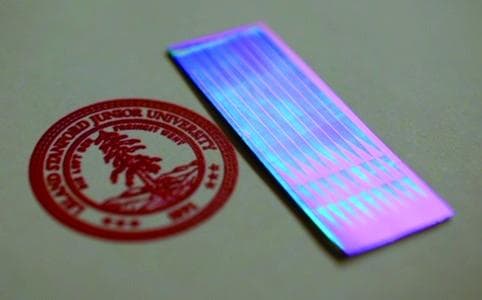Printed Electronics Made 10x Efficient With New Process
Researchers at Stanford University have developed a better way to control the flow of ink during the electronics printing process. The new method allows fewer defects in the end-product and also improves its overall electrical efficiency. Printed electronics is used to create lightweight & low-cost solar cells and also in manufacturing flexible electronics screens. However, the big problem with current methods is that the efficiency of these products is far lesser than than traditional electronics products. New process developed at Stanford is called FLUENCE aka fluid-enhanced crystal engineering. The research team expects that this new innovation will accelerate further adoption of printed electronics.

Dr Ying Diao, the lead author of the paper published in Nature Materials says that FLUENCE allows the process to be scaled up to meet the industry requirements. It's interesting to note that printed electronic devices are generally formed using semiconducting crystals. These crystals are grown using special inks containing organic chemicals. The distribution and even flow of ink, which often gets disturbed during rapid printing leads to defects in the final products.
Diao has designed a new printing blade with very tiny pillars embedded in it. These pillars mix the ink in such a way that it forms a uniform film. She has also designed a series of chemical patterns on the organic substrate to make sure that the crystals grow in a regular & uniform pattern. X-Ray studies were carried out at Stanford Synchrotron Radiation Lightsource (SSRL) and it allowed Diao to inspect the progress and keep making improvements in the process. Diao and her team were finally able to produce better arranged crystal which are at least 10x longer than the crystal created with traditional process.
Diao and her team now wants to exhamine the relationship between process & the material. This would provide even better control over the final electronic properties of the printed electronic films.
Check More On: #-Link-Snipped-#

Dr Ying Diao, the lead author of the paper published in Nature Materials says that FLUENCE allows the process to be scaled up to meet the industry requirements. It's interesting to note that printed electronic devices are generally formed using semiconducting crystals. These crystals are grown using special inks containing organic chemicals. The distribution and even flow of ink, which often gets disturbed during rapid printing leads to defects in the final products.
Diao has designed a new printing blade with very tiny pillars embedded in it. These pillars mix the ink in such a way that it forms a uniform film. She has also designed a series of chemical patterns on the organic substrate to make sure that the crystals grow in a regular & uniform pattern. X-Ray studies were carried out at Stanford Synchrotron Radiation Lightsource (SSRL) and it allowed Diao to inspect the progress and keep making improvements in the process. Diao and her team were finally able to produce better arranged crystal which are at least 10x longer than the crystal created with traditional process.
Diao and her team now wants to exhamine the relationship between process & the material. This would provide even better control over the final electronic properties of the printed electronic films.
Check More On: #-Link-Snipped-#
0
